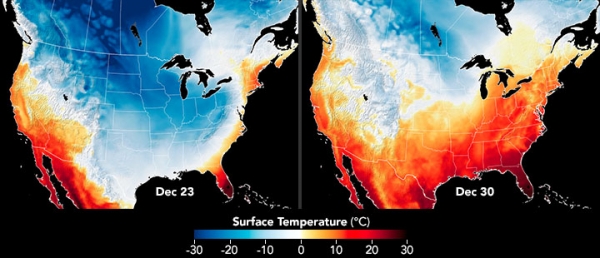December 2022 and January 2023 brought winter weather whiplash to the central and eastern United States.
In late December, many Americans reached for cold-weather gear as a blast of unusually cold Arctic air poured south and fueled a travel nightmare around Christmas. In Michigan and other parts of the Midwest, a “bomb cyclone” formed along the cold front bearing powerful winds and whiteout conditions. In certain parts of upstate New York and Canada, lake effect snow supercharged the storm, with more than 50 inches (125 centimeters) falling in Buffalo over a five-day period. The sprawling cold front left its mark on the Southeast as well, where the cold air helped fuel tornadoes, disrupted power supplies, and strained water systems.
In the first few days of January 2023, conditions changed dramatically. Instead of unseasonable cold, many of the same areas experienced unusual warmth. With temperatures running 20-30 degrees Fahrenheit higher than normal in the eastern U.S., spring-like weather broke temperature records in several states. Among the places that set new temperature records: St. Louis, Missouri; Raleigh, North Carolina; Paducah, Kentucky; Mount Pocono, Pennsylvania; Atlanta, Georgia; Georgetown, Delaware; and Dulles, Virginia.
Read More: NASA Earth Observatory
Photo Credit: Joshua Stevens/NASA Earth Observatory


